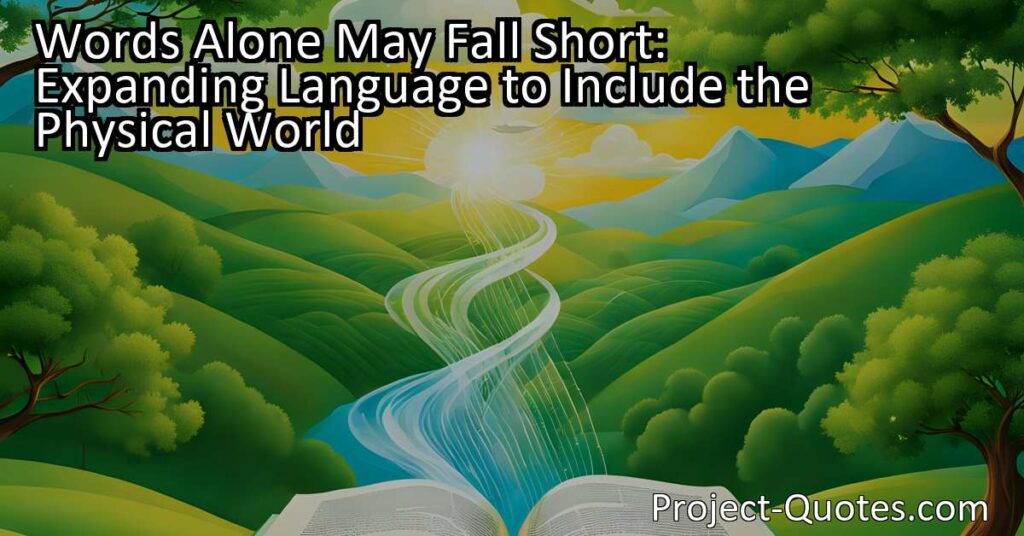Language should find itself in the physical world, and not end up locked in an idea in somebody’s head.
Robert Smithson
Words Alone May Fall Short: Expanding Language to Include the Physical World Renowned artist and writer, Robert Smithson, challenges the conventional view of language by suggesting that it should not be confined to mere words. Instead, language should expand to include the physical world, allowing for a deeper connection between our thoughts and sensory experiences. By incorporating the sights, sounds, smells, and textures of our surroundings, we can create a more holistic and authentic expression of language, going beyond the limitations of conventional communication.
Table of Contents
Meaning of Quote – Language should find itself in the physical world, and not end up locked in an idea in somebody’s head.
Language is a powerful tool that allows us to express our thoughts, emotions, and experiences. It serves as a bridge between individuals, enabling us to communicate and share ideas. However, acclaimed artist and writer Robert Smithson suggests that language should not be confined to the realm of ideas but should find its place in the physical world. In this idea, Smithson implies that language should be something tangible and visible, rather than existing solely within the confines of our minds.
When we consider language in its traditional form, we often think of it as a means of communication through written or spoken words. Yet, Smithson challenges us to go beyond this limited perspective and explore the potential of language in a more expansive sense. He argues that language should transcend mere words and manifest itself in the physical world, allowing for a deeper connection between language and our sensory experiences.
One way to understand Smithson’s idea is by examining his own artistic practice. Smithson was renowned for his works in land art, a movement that sought to bring art out of traditional gallery spaces and into the natural environment. For Smithson, the physical landscape served as a canvas for his artistic expression. Through his artworks such as “Spiral Jetty,” a massive earthwork sculpture jutting into Utah’s Great Salt Lake, Smithson promoted a dialogue between language and the environment.
By working directly with natural materials and manipulating the physical world, Smithson aimed to create a visual language that went beyond words. He believed that the physicality of his artworks would evoke a rich sensory experience, allowing viewers to engage with language on a more profound level. In this sense, Smithson’s works can be seen as a manifestation of his idea that language should find itself in the physical world.
Beyond the realm of art, Smithson’s perspective on language has broader implications for how we engage with the world around us. In our everyday lives, language serves as a means of interpretation and understanding, allowing us to make sense of our surroundings. However, if language remains confined to our thoughts and ideas, it limits our ability to fully experience the physical world.
Imagine walking through a lush forest, where sunlight filters through the canopy, birds sing, and leaves rustle beneath your feet. In this immersive environment, words alone may fall short in capturing the essence of the experience. But what if we could expand our understanding of language to embrace the sights, sounds, smells, and textures of the forest?
If we adopt Smithson’s perspective, we can start to see language not only as a tool for communication but also as a means of connecting with our surroundings on a deeper level. Instead of only verbalizing or writing about our experiences, we can actively seek to incorporate the physical world into our expression of language. This may involve engaging our senses more fully, using metaphors or similes that draw upon the natural world, or even creating physical representations of our thoughts and emotions.
For example, instead of describing a fragrant flower as “nice” or “pretty,” we can delve deeper into our sensory experience and create a more vivid description. We might say that the flower’s scent caressed our nostrils, filling the air with a symphony of sweet and delicate notes that transported us to a world of botanical delight. By expanding our vocabulary and incorporating sensory details, we bring language out of the confines of our minds and into the physical world, allowing for a more holistic and authentic expression.
Furthermore, Smithson’s idea highlights the importance of experiencing language through various modalities. While spoken and written language are undoubtedly crucial, they are not the only means through which we can engage with the world. Sign language, for instance, offers a tangible and physical expression of language that transcends linguistic barriers.
Similarly, nonverbal forms of communication, such as body language and facial expressions, also contribute to our understanding of language. By recognizing the diverse ways in which language manifests itself, we become more receptive to the idea that language can find itself in the physical world in ways that extend beyond words alone.
In conclusion, Robert Smithson’s statement that language should find itself in the physical world, rather than being confined to the realm of ideas, invites us to expand our understanding of language. By incorporating the physical world into our expression of language and engaging our senses more fully, we can forge a deeper connection with our surroundings. Smithson’s philosophy challenges us to break free from the limitations of conventional communication and explore the vast potential of language to transcend verbal and written boundaries.
I hope this quote inspired image brings you hope and peace. Share it with someone who needs it today!


